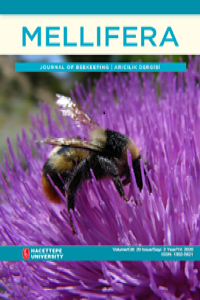Abstract
Project Number
Nil
References
- Agboola S. A., 1979. An Agricultural Atlas of Nigeria, Oxford University Press, Nigeria. P. 248Pp.
- Akinwande K. L.; Badejo, M. A.; Ogbogu, S. S., 2012. Challenges associated with the honey bee (Apis mellifera adansonii) colonies establishment in south western Nigeria, African Journal of Agriculture, Food Nutrition and Development, Vol 15: 2 : 7467 – 7484.
- Akinwande K. L.; Neumann, P., 2018. Small hive beetle infestation levels of honey bee colonies correlate with precipitation and forest cover. Apidologie, 49:517–525 https://doi.org/10.1007/s13592-018-0579-x.
- Akinwande, K. L., 2016. Hive Temperature Regulation in Colonies of West African Honey bee (Apis mellifera adansonii Latreille)(Hymenoptera : Apidae) during the wet and dry seasons. FUTA Journal of Research in Sciences, Volume 12 (2): 206 – 210.
- Akinwande,K. L; Badejo, M. A; Ogbogu, S. S., 2018. Morphometrics and parasitic load of Varroa mites (Acari : Varroidea) on Colonies of Apis mellifera adansoniii in Southwest Nigeria. 2013, Vol. 21 (1) pp 17 -25.
- Akratanakul, P., 1990. Pesticides and beekeeping. In Beekeeping in Asia, Rome : FAO Agricultural Services Bulletin. 68/4.
- Allysa C. H; Randall J. M; Evan R. C; Jeffrey D. Karron, 2017. Pollination success following loss of a frequent pollinator: the role of compensatory visitation by other effective pollinators AoB PLANTS, Volume 9, Issue 3, plx020. https://doi.org/10.1093/aobpla/plx020.
- Al-Qarni, A. S., 2006. Tolerance of summer temperature in imported and indigenous honey bee, Apis mellifera L. races in Central Saudi Arabia.- Saudi Journal of Biological Sciences 13 (2):123-127.
- Badiou-Bénéteau, A.; Meled, M.; Belzunces, L.P., 2008. Honeybee Apis mellifera acetylcholinesterase - A biomarker to detect deltamethrin exposure. Ecotoxicol. Environ. Safety. 69, 246–253.
SW Nigeria experience of Impacts of Agricultural Intensification and Climate Change on Apis mellifera adansonii Colony Establishment and Health
Abstract
Declines of wild bees together with unsustainably high losses of managed colonies and worsening bee health have become global issues. Southwest Nigeria has one of the most biologically diverse ecosystems, with the changing agricultural development and climate overwhelmingly impacting it. The impact is also significant on beekeeping vis: colony establishment, health and productivity of the native bees the West African honeybees, Apis mellifera adansonii Latreille (Hymenoptera: Apidae). This study was carried out between December, 2015 to December, 2018 to determine the stress factors associated with colony establishment, health and productivity of the bee colonies. Four states were purposively selected in the Southwest Nigeria. Some beekeepers were selected, sampling and colony observations were made in selected apiaries and laboratory investigations were conducted. Results indicated decline in colony numbers and honey production; colonies have become weakened or lost due to bee pests and diseases this is greater than losses recorded due to other factors. Infestation with small hive beetles (SHB) across the region is greater than 67(69.93 ± 2.08) (Mean ± SD) recorded for Galleria mellonella infestation. The mean levels of Gluthathion-S-Transferase (GST) detoxifier chemical signal in the tissues of bees tested in the colonies for the three years were higher than the normal value for bees. The climate change, and the adaptation policy and development such as agricultural intensification programme adopted is a relevant and sustainable mitigation tool but with a pervasive influence on beekeeping, honeybee health, population and productivity.
Supporting Institution
Nil
Project Number
Nil
Thanks
Nil
References
- Agboola S. A., 1979. An Agricultural Atlas of Nigeria, Oxford University Press, Nigeria. P. 248Pp.
- Akinwande K. L.; Badejo, M. A.; Ogbogu, S. S., 2012. Challenges associated with the honey bee (Apis mellifera adansonii) colonies establishment in south western Nigeria, African Journal of Agriculture, Food Nutrition and Development, Vol 15: 2 : 7467 – 7484.
- Akinwande K. L.; Neumann, P., 2018. Small hive beetle infestation levels of honey bee colonies correlate with precipitation and forest cover. Apidologie, 49:517–525 https://doi.org/10.1007/s13592-018-0579-x.
- Akinwande, K. L., 2016. Hive Temperature Regulation in Colonies of West African Honey bee (Apis mellifera adansonii Latreille)(Hymenoptera : Apidae) during the wet and dry seasons. FUTA Journal of Research in Sciences, Volume 12 (2): 206 – 210.
- Akinwande,K. L; Badejo, M. A; Ogbogu, S. S., 2018. Morphometrics and parasitic load of Varroa mites (Acari : Varroidea) on Colonies of Apis mellifera adansoniii in Southwest Nigeria. 2013, Vol. 21 (1) pp 17 -25.
- Akratanakul, P., 1990. Pesticides and beekeeping. In Beekeeping in Asia, Rome : FAO Agricultural Services Bulletin. 68/4.
- Allysa C. H; Randall J. M; Evan R. C; Jeffrey D. Karron, 2017. Pollination success following loss of a frequent pollinator: the role of compensatory visitation by other effective pollinators AoB PLANTS, Volume 9, Issue 3, plx020. https://doi.org/10.1093/aobpla/plx020.
- Al-Qarni, A. S., 2006. Tolerance of summer temperature in imported and indigenous honey bee, Apis mellifera L. races in Central Saudi Arabia.- Saudi Journal of Biological Sciences 13 (2):123-127.
- Badiou-Bénéteau, A.; Meled, M.; Belzunces, L.P., 2008. Honeybee Apis mellifera acetylcholinesterase - A biomarker to detect deltamethrin exposure. Ecotoxicol. Environ. Safety. 69, 246–253.
Details
| Primary Language | English |
|---|---|
| Subjects | Structural Biology, Environmental Sciences |
| Journal Section | Articles |
| Authors | |
| Project Number | Nil |
| Publication Date | December 31, 2020 |
| Submission Date | November 29, 2020 |
| Acceptance Date | December 31, 2020 |
| Published in Issue | Year 2020 Volume: 20 Issue: 2 |

